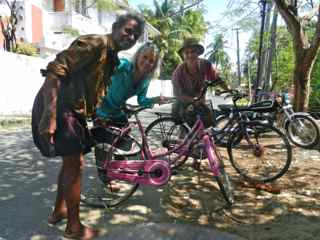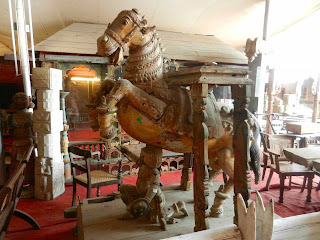I try not to be judgemental. I have a hard time accepting some
things about Indian culture.
Gender roles are ultra-defined.
Women’s roles are strictly set out, and “happily” adhered to by
most. One wife wakes up at 4:30 am
to make sure she has time to prepare lunch for her husband before he leaves for
work at 7:30. When she was ill and
spent two days in hospital, her husband and son checked into a hotel. God forbid they should actually make
food for themselves for two days – just not done.
 |
| Sandia's Family and Neighbours |
Many men work away from home. In one family, the husband works in
Dubai, and only comes home to Kochi for two weeks a year at Christmas
time. This is normal and common.
Boys and men frolic on the beach, swimming
and playing together, in bathing suits and western clothing. Women watch. A couple of them may go in the water, fully clothed in their
traditional saris. This is normal,
and totally accepted.
Most don’t know how to swim, though they
are surrounded by water. A houseboat
in Allepei tipped at the dock, and two children and two women died, and many
were injured. We heard of another
tragedy, where 40 children from 10 to 12 years of age were on a field trip from
school, on a wooden boat with a capacity for 20 people. The boat sunk and dozens died. They couldn’t swim, and there were only
a couple of life jackets, not in use.
We saw a celebration in Munnar with 25
women dancing freely together – the husbands were nowhere to be seen. If they were there, the women could not
be free to dance, since the husbands would not like other men to see “their
women” dancing. Only when the men
are not around are the women free to “party”.
 | |
| Women Dancing |
On the buses, women sit at the front, men
in the rear. Even Amy and I
separate in deference to the custom.
Why?
In the little restaurants, dozens of men
sit, no women to be seen. They are
at home, cooking and cleaning for their families.
Whatever the man says, this is what is
done. Yet the women appear strong,
happy and not meek. Most seem to
accept this reality, without question.
If a woman is divorced or widowed, there is
usually no consideration of remarriage, and even if there are children, they
are left to provide for them alone, often with extreme deprivation. We did hear that in the Muslim
community, a brother of the husband or other family member might marry the
woman – perhaps an additional wife – to provide. But in the Hindu tradition, this is not done.
Men leave their wives, and there is nothing
to be done, no help, no support.
To me it seems unfair, but in this world, it is accepted as what
is. My western judgement
(discernment?) cries out that this is completely unfair, but I don’t know if
it’s seen that way here. It’s hard
to fathom.
Yet, the people seem happy, so friendly,
warm and genuine. Perhaps it is
the daily spiritual connection that allows them to accept what is with grace
and make the best of it. I don’t
often hear complaints, but do experience their sense of gratitude to God or the
Cosmos for life, however it is presented.
Children rarely cry, except for very young
babies. They seem content, happy
with their family life, and curious to meet us “fresh monkeys”. Yet we hear that children are beaten
(the “bamboo massage”) and this is acceptable, as long as it is done to teach
and not because of uncontrolled anger.
We hear stories of rape of daughters by fathers, and sometimes these
things are reported and dealt with, sometimes not. Sometimes the mothers say and do nothing to stop it.






























